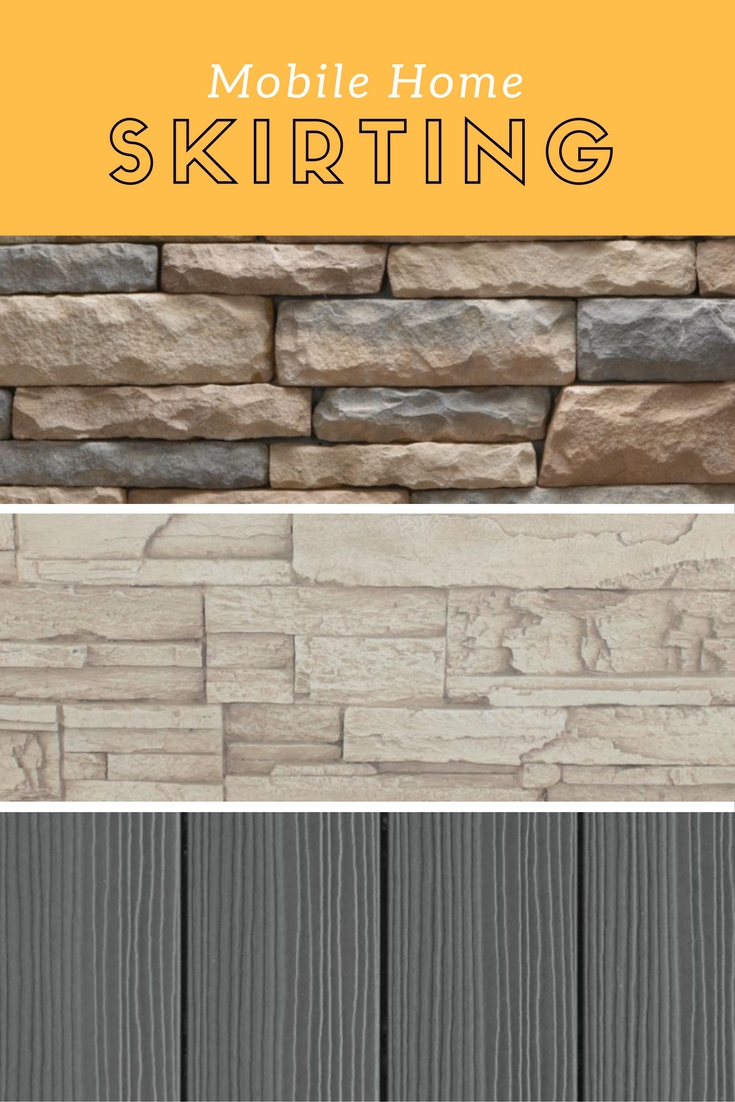
Mobile homes have an open space underneath which can be a haven to animals. Rainwater or snow may also collect there, which can raise one's energy consumption by driving temperatures down.
Skirting is a practical method of protecting a mobile home from invasion by rodents (such as rats and critters) as well as other elements from creeping in.
Skirting also enhances the appeal of the home since there’s a wide range of mobile home skirting ideas available to choose from. It also hides wheels or axles and most importantly, will lead to considerable savings in energy bills. If one has a mobile home, they can do skirting as a simple DIY.
Here at Home Nation, we pride ourselves on providing high quality mobile homes with affordable prices. With our expertise in both, we’ll dig into everything you need to know about mobile home skirting. Let's get started.
What is Mobile Home Skirting?
Mobile home skirting is the process of covering the space underneath a mobile home to protect from animals, cold, snow and water. Skirting protects the plumbing work and ensures pipes or ducts do not freeze during winter. An adequately installed skirt will provide storage space where one can tuck away items they don't occasionally use.
If you're not sure of the material you need for skirting, there’s always an option to contact a professional to come and do an assessment and give a cost estimate. Experts will advise on the best product depending on the type of mobile home, budget, climate, and personal preferences of the homeowner.
Related: What Options Should I Choose for My Mobile Home?
Skirting Solutions
The market is awash with a variety of skirting solutions for mobile homes. Popular options include Vinyl, concrete, metal foam, wooden, foam, and faux rock.
Before one hits the store, it's essential to gather the material they’ll need for their skirting. First, they must know the overall dimension of the open space in terms of length, width, and height. These are some of the things their supplier will need answers to.
Also, it saves on cost since one only needs to buy the right size for their home. Other materials include screws, long planks, chalk, and circular saw.
The mobile home skirt is easy to fix, although you may need extra hands. So grab some pizza and call in that favor with a friend or two for a day to help with skirting.
Plywood Skirting

Plywood skirting involves creating a panel underneath. Once you’ve gathered the materials, you’ll need to attach wooden screws to the plank while leaving an overhang beneath. This overhang secures the skirting since it’ll wrap above it.
You’ll need a panel where they can do plumbing works, repairs, and maintenance. The panel will be an ideal storage space for small tools.
The main disadvantage of wood skirting is that its wood is prone to rotting and decay when exposed to water. However, one can use a water resistance material underneath the plywood to protect from exposure to water or moisture and enhance durability.
Vinyl Skirting
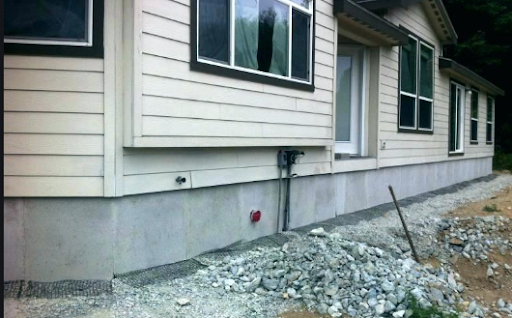
Vinyl skirting is popular among homeowners since it’s cheap, affordable, and fixing is bliss. It accentuates the appearance of one's home, and it's a beautiful addition that blends with one's style. When installing, you can start by cutting the bottom of the panels and aligning to the ground using a power saw.
That said, it has its downside and previous users have complained of flimsiness, therefore, may not withstand strong winds, running water and storms. Also, when weeding, the strings may damage the skirting rendering worthless.
Maintaining the beauty of one's Vinyl skirting requires regular cleaning with a mild detergent and water. Painting is not ideal, and it's important to keep grass and other vegetation away by regularly weeding.
Faux Rock Skirting
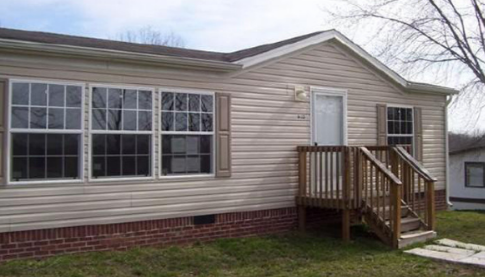
Faux rock skirting is popular since it’s a bit sturdy and will hold well even where there's vegetation. They are therefore not easily damaged by weed, unlike the vinyl skirting.
Faux rocks are made of a lightweight polyurethane material, and from a distance, one may mistake it for a rock. However, if one wants a real rock, it will cost them more. For a more classic appeal, you can use faux rocks that look like bricks.
The advantage of the rock is that it takes care of one's home and blocks the effects of adverse weather such as rainwater, snow, and cold.
Although the polyurethane faux panels are pricey, they are beautiful. However, one can create frames to make them secure. Nonetheless, you may also need to back the faux rocks with plywood and caulk for more support.
Also, there is a wide variety of them, and one can choose the best color that blends with their home decor. When it comes to cost, they are pricy, unlike Vinyl; however, stone panels cost even more. Real stones are strong and may not be affected by strong winds.
Metal Skirting
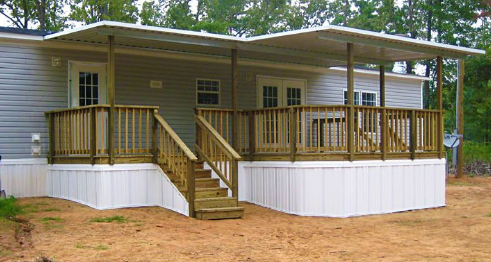
Metal is readily available, and most people prefer using it for skirting their home since its sturdy. It's also fairly affordable, and installation is simpler when compared to wood and Vinyl.
Metal also provides different skirting styles such as a ribbed panel. One can place the panels underneath and paint it with their favorite colors.
The fact that it's strong means it can withstand the effects of wind or water. If you’d prefer a shiny appeal, you can choose corrugated panels which were popular back in the day.
Ribbed metal panels are available in different colors, and some suppliers usually have a warranty in case of color fade. However, if one wishes for extra strength, they can choose thick panels.
Skirting Ventilation
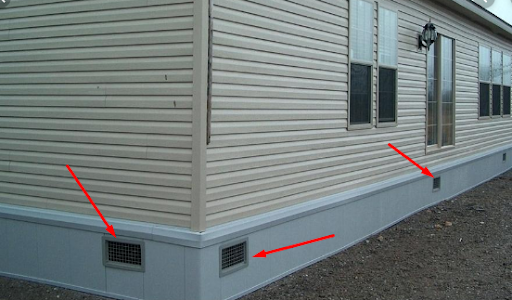
If one lives in a mobile home, it's essential to consider skirting ventilation. It's crucial to avoid air spaces by using insulated vents to control the temperature. Also, ensure the access door is near the water pumps and the vents.
Other Types of Skirting
You can save on costs by using ready-made materials instead of buying faux rocks, plywood, metal, or Vinyl. For instance, old roofing made of metal or corrugated metal. Also, railroad bars are useful for home skirting. The essence of the roofing is to block rain, water, or small animals from getting in.
Concrete/Stucco Skirting
Concrete skirting panels, or stucco skirting, is a sturdy option that resists pest invasion and rot. Some of the popular brands that offer concrete skirting come with hidden ventilation panels that give your skirting a seamless look but still give your home the proper ventilation needed to resist gas and moisture buildup underneath your mobile home. Stucco skirting is heavy and more difficult to install than other options, but it is extremely durable.
Cinder Block and Brick Skirting
While some resin and vinyl skirting options can look like blocks or bricks, you can skirt your home with real cinder blocks or bricks. If you choose this skirting, it doesn’t mean that your mobile home now has a permanent foundation, but it can add some style to your exterior and give it the appearance of being on a permanent foundation.
Fiber Cement Skirting
You can even use siding material to skirt your mobile home. Fiber cement typically gets used for a home’s siding, but you can skirt your manufactured home with it. Some companies that sell fiber cement siding will even give you a warranty with it, as long as you install it in accordance with their brand guidelines.
Lattice Skirting
Skirting your mobile home with either wood or vinyl lattice typically means that you won’t have to worry about ventilation; the lattice pattern naturally allows air to flow freely underneath your home. Wood lattice is typically inexpensive and easy to install but is susceptible to rot and mildew. Vinyl lattice skirting comes in various colors and unique patterns to give you a highly customizable skirting option.
Factors to Consider when Choosing the Best Skirting for One's Mobile Home:
The issue of cost is an essential consideration since it affects the skirting material you choose. Although a pricey skirting will boost the appearance of the home, it's essential to operate within one's budget.
Also, cheap may be expensive and what one picks should give value for money. After all, you need something durable and that which will get the job done.
The weather situation and the climate where the mobile house is situated is an important matter to consider. If the area is rainy, the best material is faux rocks since it's secure and will hold well against the water. Vinyl and metal skirting will do well in hot areas.
Also, polyethylene material doesn’t react with water and consequently will not corrode or rust. Similarly, if the place is snowy, then you should consider an insulation material to protect against the cold. Also, you should ensure the skirting does not touch the bottom since the ground may rise due to snow and damage it.
If the mobile home is on your land, you can consider permanent options such as faux rocks. Also, bricks will work well, and this may transform the home to a permanent home and raise its value.
The type of material will depend on the needs of the homeowner and whether they will move to another location soon. In this case, metal skirting is ideal since it's easier to install and disassemble, unlike brick.
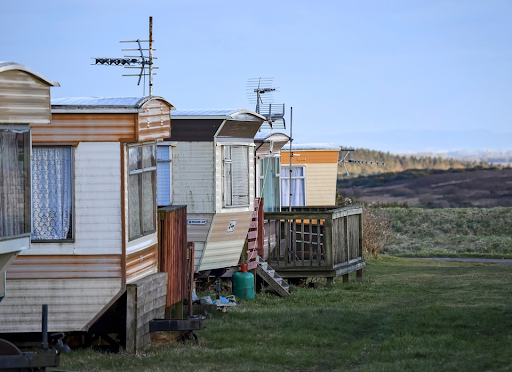
Shopping for Skirting Material
After you've evaluated the options available for skirting, it’s time to hit the stores and stock up on your desired product. You can source most, if not all skirting materials in your neighborhood hardware store. Likewise, you can order the materials online, and several virtual stores stock these products.
When shopping in physical stores, you can simply pop in and pick their selection. The main consideration with sourcing locally is delivery - you’ll probably have to lug the goods back home yourself. Some hardware stores may have after-sale services. A key advantage of sourcing locally is that helping hands at a local store can offer advice on setting up.
How Much Skirting Does Your Mobile Home Need?
Before installing your mobile home skirting, you first need to know the precise amount you need. How do you figure this out? The good news is all you need to do is some simple math. First, get the total square footage that comes with your mobile home.
You can calculate this by measuring each side of your home, then adding the sides together. Make sure you also include any porches in these measurements. Next, determine the average distance between your house and the ground.
You can measure the distance to the floor at each corner. Then add all the numbers up and divide them by four to find the average. With these two figures, you can determine precisely how much skirting your mobile home requires.
What Tools Do You Need to Install Skirting?
If you’re a handy person, you might consider installing the skirting on your mobile home. Remember that if you do this, you will require specific tools. Here’s what you’ll need for most skirting jobs:
-
Utility Knife
-
Nails
-
Hammer
-
Wood stakes
-
Tin snips
-
Spikes
-
Drill and bit
-
Level
-
Tape measure
If you don’t have some of these tools, or you don’t have the knowledge to install the skirting, don’t feel bad hiring a professional. As we’ll see, there are a lot of benefits that come with hiring one.
Does Your Skirting Need to Be Insulated?
There’s a lot of disagreement when it comes to whether or not your skirting needs to be insulated. The answer to this question ultimately depends on where you live.
If you live in a place with fierce winters, insulating the skirting can be worth it. However, if you reside in an area with a more temperate and warm environment, you don’t need it to be insulated.
The Cost of Mobile Home Skirting
The cost of skirting can vary heavily, and largely depends on the type of material, preparation works, and the size of the mobile home. If you're not sure about the cost, it’s well worth the upfront time of calling in an expert to draft a bill of quantities in regards to the cost of material and labor. The cost of labor will depend on the handyman since some charge per hour while others per job.
However, homeowners need to discuss the issue of costs with the professionals before the job kicks off to avoid disagreements. It's always important to mention to the handyman the amount of money you have budgeted for the entire project.
Mobile home skirting can elevate the value of one's home since it offers an attractive appeal. It also keeps the house clean as well as deterring small animals. These animals may camp underneath and lead to deterioration in the value of one's property - not to mention triggering diseases through contamination.
When looking at the issue of costs, individuals can do the installation themselves, which is cheaper or may involve a handyman. Sometimes installation may require removing old skirting material and fitting with new ones. In this case, the cost may shoot up since it's like a renovation. Other costs also include the cost of painting and decoration.
Mobile home skirting will maintain and protect the value of one's home. It also protects the overall structure of one's home, including pipes, vents, electrical installations, and ducts from damage. Therefore one's mobile home will not lose value since water will not sip through and damage the bottom - so most of the time, it’s a worthwhile investment.
Installing Mobile Home Skirting
If you want to install your mobile home skirting yourself, some companies do sell kits, but it can require a lot of expertise and hard work. When installing skirting, you also must check local requirements regarding inspections and permits -- improper installation could void insurance claims or your home’s warranty.
If you choose to install the skirting yourself, it’s important to ensure that your home gets proper ventilation, and you have to get the correct amount of panels and accommodate for possible variations in height. Vinyl is typically the easiest material for a DIY skirting installation.
Benefits of Hiring a Professional
There are plenty of benefits that come when you hire a professional mobile home skirting installer. For one thing, their experience means that they’ll finish the job a lot quicker than you.
And if you choose the correct installer, they’ll also do a quality job that looks great at the end of the day. Professionals can also give you valuable insight. A professional can provide you with advice on the best materials for your specific circumstances.
For example, there might be a particular type of skirting that’s right for where you live. Lastly, a professional will handle all the details and stress that often come with the installation. This will include getting any necessary permits for the job.
How to Find the Best Professional
The easiest way to find an excellent skirting installer is a quick Google search. Make sure you read the reviews to get a better sense of the average person’s experience with them. You should also ensure they’re licensed, insured, and bonded.
That way, you know they’re qualified for the job. Have them come out for a consultation to get a complete idea of whether or not they’re the right person for the job.
Skirting Maintenance Tips
Taking good care of the skirting will save the owner replacement and repair costs. It also ensures the mobile home doesn't depreciate. Other than that, a beautiful skirting will turn heads and can be the center of attraction.
The skirting should be adequately fixed with proper ventilation to prevent moisture build-up and growth of mold. Once in a while, you should look to weed out unwanted plants near the skirting. This is also a good time to apply a fresh layer of paint in case of metal skirting to prevent rusting or corrosion.
If the skirting material is polyurethane, you’ll have to maintain a regular routine of washing with soap and water. After all, the skirting forms the external part of the mobile home - that’s what everyone sees!
Misconceptions About Mobile Home Skirting
Although mobile skirting blocks the space underneath, the question of whether your home will change to a permanent one depends on the materials used. Also, you might need to look at the sturdiness and how the materials anchor.
Related: How Large Can a Mobile Home Be?
Takeaway
Skirting is a great DIY project that most people can do on their own - all you really need is to have the tools and equipment to complete the job. Even for bigger jobs, it’s a great opportunity to rally the troops and make a day of it. For more involved jobs using brick or rocks, it’s worthwhile investing in expert advice to give your mobile home enviable longevity.
Either way, this post offered a solid primer on the different skirting techniques and has given you a better understanding of the options available. Check out our prefabricated homes and used mobile homes at HomeNation with a variety of skirting options. Good luck!
Are you looking for a new or used mobile home with a wide variety of skirting options? Don’t forget to check out HomeNation’s selection!
Related: What Questions You Should Ask Before Buying a Mobile Home





